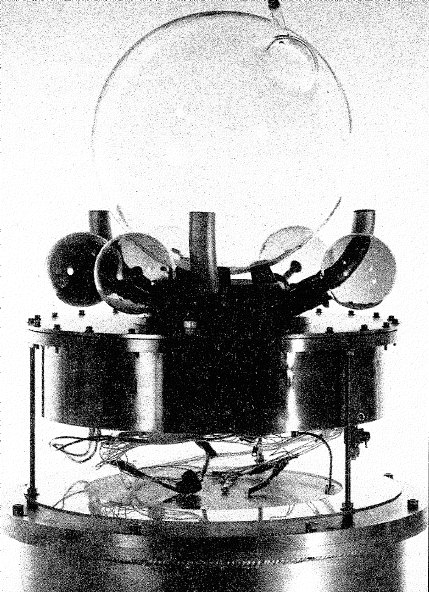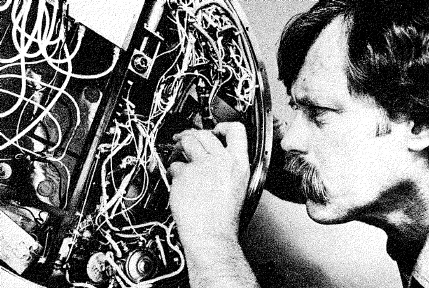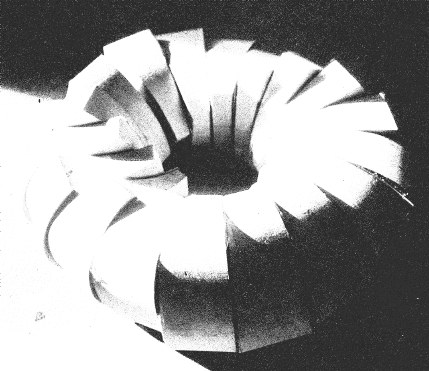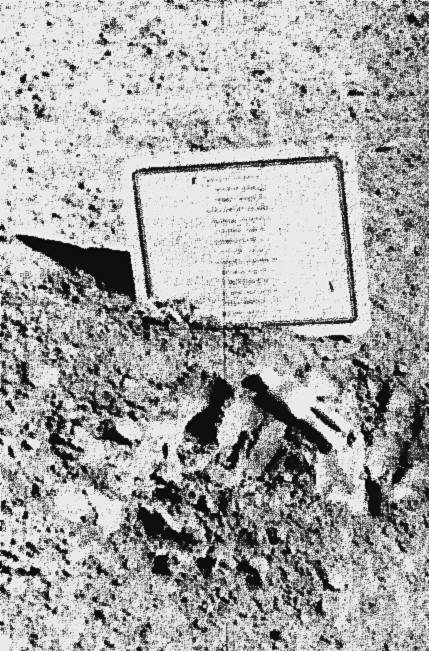ART
|
© copyright 1985 by Robert Horvitz Originally published in the Whole Earth Review issue 48 (Fall 1985), pages 26-31. An earlier version was published as "For the Reasons of Poetry: Arting in Space" in Art Papers' May/June 1985 (pages 5-8). |
Just after 7 a.m. on October 5, 1984, the space shuttle Challenger blasted off from Kennedy Space Center in Florida.
As usual, it had a variety of payloads in its cargo bay, including a trash-can sized canister mounted unobtrusively along a side wall. Known to the flight crew simply as "Payload G-38," this padded aluminum cylinder held the elements of the first sculpture to be fabricated in space.
Among other things, G-38 contained a clear glass globe about 14 inches in diameter, fitted with a flexible stainless-steel tube and a valve. It left the Earth filled with 22 liters of sea-level air at sea-level pressure. In orbit, the valve was opened for several days by the payload's control system to establish equilibrium between the globe and its environment. The sphere came back to Earth with 22 liters of ultra-thin upper atmosphere. Now permanently sealed, it is attached to a vacuum gauge with digital readout. The gauge is sensitive enough to show moment-to-moment changes in the pressure-difference between the space vacuum inside and the atmosphere outside pressing against the sphere.
Joseph McShane, the artist responsible for Payload G-38, says, "The sculpture then is not the glass, but the outer space contained within. The sphere serves only to keep the one-g Earth atmosphere from intruding." Its presence gives the air around it presence by contrast.
A different daring space sculpture project is planned for launch early next year. Joe Davis, a fellow at MIT's Center for Advanced Visual Studies, and colleague Eric Begleiter, intend to orbit a high-power electron gun in an attempt to create an artificial aurora. The device is now being built with help from MIT's High Voltage Research Laboratory. The equipment is donated by a growing list of small high-tech companies. If all goes as planned, a narrow ten-kilowatt beam of electrons will shoot down from the shuttle's cargo bay nearly a hundred miles to the denser layers of the ionosphere, causing them to glow. There are still too many unknowns to predict how this will look from the ground, but it may resemble a faint, streaky, luminous cloud that brightens and fades with the pulsing of the beam. It would only be visible at night, of course, in clear, dark skies along the shuttle's flight path. Davis calls the project New Wave Ruby Falls - alluding to Ruby Falls, Tennessee, site of an artificially-lit underground waterfall advertised as a tourist attraction on roads throughout the South.
Artificial aurorae have been created before, using rockets to release chemicals in the upper atmosphere, and the shuttle has already flown large electron guns for other purposes. But Davis' proposal is quite novel. Most space researchers initially doubted that it was even possible. That he has been able to convince so many that it is not only possible, but environmentally safe and scientifically worthwhile, is testimony to his persistence, and to the magic of the idea itself. Ruby Falls fires the imagination of many people and has gotten a fair amount of media coverage. This has been essential to the project, attracting donations of equipment, skills and labor from those inspired by what Davis is trying to do. (If you are so inspired, you can contact him c/o the MIT Center for Advanced Visual Studies, 40 Massachusetts Ave., Cambridge, MA 02139.)
Davis has another, less dramatic payload, LightFlight, which is being put together by students at the Rhode Island School of Design, and which may fly before Ruby Falls. A small but very bright strobe-light, mounted in a GAS [Get-Away Special: see WER #45, page 26] canister, will be aimed down at the Earth. The purpose of the investigation is to try to resolve uncertainty about the minimum point-brightness that can be seen by the unaided human eye, and to test the practicality of using this kind of lamp for optical signalling from the orbitting shuttle to observers on the ground. A subsequent mission would have the light beam modulated with slow-scan television images, and eventually he hopes to flight-test a two-way Earth/orbit light link.
To be able to work in space, Davis, like McShane, has had to cast his art in the mold of science in order to qualify for the GAS program. Davis says, "NASA would neither qualify nor disqualify a project simply because it contained or pertained to a work of art, though clearly if the artistic and scientific aspects of such a payload could be at all separated, then NASA would fly the science and not the art. Here integration of the sensibilities was as important as integration of the hardware."
Since Davis and McShane both want their work to "integrate the sensibilities" anyway, this has not been a problem for them. But not everyone shares this aim. What about those who would like to use space for creative projects that are not even remotely scientific?
Consider Lowry Burgess (head of the graduate program at Massachusetts College of Art in Boston and also a fellow at MIT CAVS). For years he has been trying to get permission from NASA to put a piece called The Gate Into Aether over the Pacific:
"The Gate Into Aether is a ring form of ice consisting of 18 sections of frozen waters taken from the mouths of 18 great rivers throughout the world (Mississippi, Congo, Columbia, Ganges, St. Lawrence, Danube, Rio Grande, Indus, Rhine, Tigris-Euphrates, Amazon, Yang Tzu, etc.). These rivers are combined in pairs with other waters from springs, waterfalls, geysers, glaciers and wells... between each of the frozen sections are sonic holograms (wave fronts of sound captured in light) of the ecstatic singing of plants, animals, and people."
As Burgess envisions it, the ice-ring, measuring about 18 inches in diameter, would be taken out of a refrigerated container by a shuttle crew-member and gently placed over the Pacific by hand: a crowning. The ice would sublime (evaporate without melting), leaving the holograms to flutter down into the atmosphere like leaves, burning completely during re-entry:
"As if animated by a surprising impulse waters were from all over the world... gathered face to face and mouth to mouth: memory of the world as water...welded by a chill rapture of song lifted into high and absolute silence at the rim of the world...released, sublimed as crystals, as the sun scatters the starry night in a diasporal seeding of the streams in air, an infinitessimal rain..."
Until recently, NASA forbade the deployment of solid objects from GAS canisters, even when they were sure to disintegrate quickly. (That's one reason why Davis chose to work with electromagnetic rays, and McShane, sampling containers.) More to the point, Burgess sees the gesture of placement by a human hand as important to the symbolism of his piece. But NASA won't allow any extravehicular-activity time to be spent in support of a GAS payload. Even if they did, he would still have to convince them that the ice ring can be safely handled and deployed. That may be harder than it sounds: unless all gases dissolved in the waters are purged before freezing, it could erupt when exposed to sunlight and vacuum, hurling the sharp-edged holograms every which-way. Careful engineering can probably dispel the safety issues. The main problem, though, has been that The Gate Into Aether just isn't scientific or technical research by any stretch of the imagination. Rather than disguise that fact, or redefine the project to fit the requirements of the GAS program, Burgess has been trying to get NASA to change its policies to allow the shuttles to carry nonscientific payloads. On August 31, 1984, they did so.
Under the new rules, nonscientific payloads are eligible for flight on a "space available" basis - that is, after all scientific and technical payloads have been accommodated. Formal flight requests must be accompanied by a processing fee of $1000. They're first screened for safety, feasibility, compliance with regulations, etc., then must be approved by a Nonscientific Payload Evaluation Committee composed of high-level NASA administrators. The basic flight fare is just under $1500/pound, plus "integration" fees figured on a case-by-case basis for handling, installation, etc.
From the Federal Register (August 31, 1984, pages 34445-34447):
"No payload will be accepted for flight which is inconsistent with NASA's mission or otherwise not in the national interest. No human or animal life will be permitted in a nonscientific payload. Nonscientific payloads will not be permitted as free flyers (untethered satellites)... all nonscientific payloads will be returned to Earth aboard the same [Space Transport System] flights that carry them into orbit...
"NASA specifically reserves the right to reject nonscientific payloads proposed - or which appear to be proposed - solely or primarily for the purpose of advertising, publicity, endorsements, or other means of promotion."
These rules still preclude work like "The Gate Into Aether": nothing solid can be left in orbit. "In addition," says NASA,"we do not wish to increase the number of space objects that re-enter Earth's atmosphere."
Recently, however, Burgess filed a flight request for another piece called "The Boundless Cubic Lunar Aperture." This one does not require waiver of any regulations or pose safety problems. Approved by the committee this past spring and tentatively scheduled to fly by the end of the year, it will be the shuttle's first fare-paying nonscientific payload.
The form and symbolism of "The Boundless Cubic Lunar Aperture" are too complex to describe here in full, but the basic structure is that of two sets of boxes-within-boxes - one to be installed near the DeCordova Museum in Lincoln, Massachusetts, the other to be put someday in the crater Korolev, on the far side of the moon. The two sets refer to each other by approximately inverting each other's nesting order. The outer surface of the terrestrial set is tiled with small blocks of bronze, blue pearl granite, and smokey lead glass; the inner-most cube is a vacuum lined with "holograms of nothing" (six exposed but blank glass plates). The innermost cube of the lunar set will be made of the bronze, granite and glass blocks; its outer surface, exposed to the lunar vacuum, will be covered with holograms of visionary scenes: a foot splashing in water, a hand metamorphosing into a tree covered with wings instead of leaves.
Only the 5" x 5" x 5" core of the Earthly set will fly on the shuttle, says Burgess: "a cubic pressure chamber which contains all the chemical elements: solid, liquid, and gaseous. This chamber also contains the purified waters of 'The Gate Into Aether.' In this pressurized and elemental vice floats a further cubic vessel framed with its six holograms of nothing: a cubic vacuum."
When the core returns from orbit, the remainder of the terrestrial piece will be built around it. Completely assembled, it will be embedded in an outcropping of 300-million-year-old rock a few miles from Walden Pond. (The crater Korolev was chosen as the complementary site because some of the moon's oldest rock is thought to be exposed there.)
Burgess' work is closer in spirit to alchemy than to science, a kind of material poetry. There is no logical justification for its soon-to-be-unseen heart to spend a week in orbit before being interred, but each component of the "Aperture" has undergone a processing ritual in an appropriate, usually out-of-the-way, place: the waters from "The Gate Into Aether" were distilled on the edge of the Dead Sea, the "holograms of nothing" were exposed in a cold, lightless cave under the crater of an extinct volcano. The ride into space will link the inside of the terrestrial cube to the outside of the lunar cube. "The Aperture," says Burgess, is "a labyrinthian keyhole through Void, framed in fractured and fused cancellations, a dread knot." Arcane, serendipitous, it represents a kind of thinking that NASA has never been able to accommodate before, but which in fact imposes very little burden on their operations.
McShane, Davis and Burgess have not run into any problems with NASA on the issues of personal gain and publicity stemming from their spacework. This is a subject on which the agency is known to be sensitive, however. One incident in particular made them wary.
A Dutch artist, Paul Van Hoeydonck, persuaded NASA to let the Apollo-15 astronauts place a small sculpture of his on the moon in 1971. Titled "The Fallen Astronaut," the satin-finished milled-aluminum figurine was left on the lunar dust with a plaque listing all of the astronauts and cosmonauts who had died during previous space missions. This simple tableau is a tasteful and poignant tribute to those who gave their lives in the early days of space exploration, yet it is virtually forgotten today - in part, no doubt, because NASA disapproved of the way Van Hoeydonck's gallery capitalized on the event. "FIRST ART ON THE MOON" was the bold headline of the full-page ads the Waddell Gallery placed in leading art magazines, offering 950 copies of the figurine, each one signed and "similar in the most exact detail to the sculpture on the moon," for $750 apiece (950 x $750 = $712,500).
It's uncertain how they would react to a similar event today. Astronauts have been reprimanded for carrying postage stamps and souvenirs into space for private sale on Earth. Van Hoeydonck got permission to have "The Fallen Astronaut" left on the moon, but it isn't clear if NASA knew about the 950 clones or the marketing plans ahead of time. They still forbid the use of launch services simply to create souvenirs.
On the other hand, this is the era of Reaganomics, of space commercialization, of public assets being used to foster private enterprise. How this will affect the Nonscientific Payload Program remains to be seen. The rule barring payloads that "appear to be proposed...primarily for the purposes of... publicity [and] promotion" shows there are limits to what NASA will tolerate in the way of orbiting attention-grabbers - though there's no prohibition in the rules against payloads being launched for financial gain.
Profit may prove to be the most common motive for nonscientific shuttle projects in coming years, but that isn't why NASA created the program. "We began to look seriously at developing a nonscientific payload policy because of inquiries from members of the arts community," recalls Tony Maull, the evaluation committee's executive secretary. "People like Joe Davis and Lowry Burgess and others who were using very modern materials and techniques. We saved all of these proposals, waiting for the day when we finally got the shuttle operating and on a reliable schedule, and as that day approached, we went through our files and tried to figure out how we could best accommodate the people who wanted to send up nonscientific payloads. We really had mainly artists in mind, because their representations had been the most vigorous and the best thought-out...
"I think that all of us at NASA are clearly aware that what motivates the American people to support the space program - and it is their program, not a hobbyshop for us - isn't just for the reasons of science and engineering, but perhaps as important, for the reasons of poetry, the spirit of adventure. We're moved to be off [the Earth] for reasons that are probably harder for engineers to understand than for artists. We're not going to get involved with judgments of artistic merit. We just want people to know that the door is open now for concerns that go beyond science and engineering."
For information about how to submit proposals for nonscientific shuttle payloads and current prices, contact:
Customer Services Division
Code MC
Office of Space Flight
NASA Headquarters
Washington, DC 20546
| POSTSCRIPT: In January 1986, the space shuttle Challenger exploded just after launch, killing all of those on board. NASA suspended all shuttle flights until 1988, and when they resumed, public access to shuttle services was very limited. In March 1989, Lowry Burgess' Boundless Cubic Lunar Aperture was the first - and only - nonscientific payload launched under the rules described in this article. Joe Davis' payloads never flew. |

STS Challenger begins its second mission (photo by John Young)

Payload G-38 after returning from space (photo by Charles Lyon)

Joe McShane adjusts Payload G-38's control system before final assembly and launch (photo by Charles Lyon)

Molds for the 18 ices forming The Gate Into Aether by Lowry Burgess (photo by Janet Burgess)

First jazz solo in space? Astronaut Ronald E. McNair improvises on the saxophone while floating in Challenger's mid-deck, February 1984 (NASA photo)

The Boundless Cubic Lunar Aperture (partly assembled) by Lowry Burgess (photo by Janet Burgess)

The Fallen Astronaut by Paul Von Hoeydonck. In August 1971 a small milled aluminum figure was left on the moon next to a card listing the 14 astronauts and cosmonauts who died prior to the Apollo-15 mission. NASA later distanced itself from this modest but effective gesture when Von Hoeydonck's gallery launched an aggressive advertising campaign to sell 950 replicas.
Noncommercial electronic distribution of this article is permitted so long as it is kept intact, including this notice. |